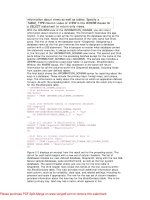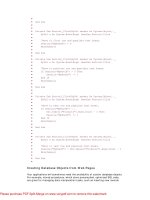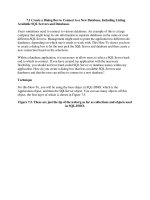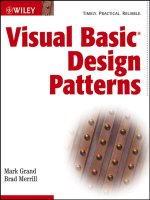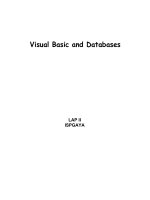Visual Basic and Databases pdf
Bạn đang xem bản rút gọn của tài liệu. Xem và tải ngay bản đầy đủ của tài liệu tại đây (1.03 MB, 270 trang )
Visual Basic and Databases
LAP II
ISPGAYA
Visual Basic and Databases
© LAP II
ii
Notice
This guide was developed for the course, “Visual Basic and
Databases,”. It is not intended to be a complete reference to
Visual Basic. Consult the Microsoft documentation that comes
with your particular version of Visual Basic for detailed reference
information.
This guide refers to several software and hardware products by
their trade names. These references are for informational
purposes only and all trademarks are the property of their
respective companies.
Contents
© LAP II
iii
Visual Basic and Databases
Contents
1. Introducing Visual Basic and Databases
Preview 1-1
Course Objectives 1-2
Course Requirements 1-3
What is a Database? 1-4
Where Does Visual Basic Fit In? 1-6
Building a Visual Basic Application 1-8
Structure of a Visual Basic Application 1-8
Steps in Developing Application 1-9
Drawing the User Interface and Setting Properties 1-9
Setting Properties of Controls at Design Time 1-13
Setting Properties at Run-Time 1-14
How Names are Used in Object Events 1-14
Writing Code 1-15
Review of Variables 1-15
Visual Basic Data Types 1-15
Variable Declaration 1-16
Example 1. Mailing List Application 1-18
Summary 1-25
2. Introduction to Databases
Review and Preview 2-1
Database Structure and Terminology 2-2
Relational Databases 2-3
Sample Relational Database 2-4
Sample Database Structure 2-7
Virtual Database Tables 2-8
Creating a Database 2-10
Summary 2-11
Visual Basic and Databases
© LAP II
iv
3. Database Connection with the DAO Data Control
Review and Preview 3-1
DAO or ADO – What’s the Difference? 3-2
DAO Data Control 3-3
DAO Data Control Properties 3-4
Recordset Object 3-5
Data Bound Controls 3-6
Data Bound Control Properties 3-6
Example 3-1. Accessing the Books Database 3-8
DAO Data Control Events 3-11
DAO Data Control Methods 3-11
DAO Data Control Recordset Properties 3-12
DAO Data Control Recordset Methods 3-13
DAO Data Control Recordset Navigation 3-14
Quick Example 1 - Recordset Navigation 3-15
Summary 3-17
Exercise 3. Northwind Traders Database 3-18
Contents
© LAP II
v
4. Database Connection with ADO Technology
Review and Preview 4-1
ADO Data Control 4-2
ADO Data Control Properties 4-3
ConnectionString Property 4-4
Recordset Object 4-5
Data Bound Controls 4-6
Data Bound Control Properties 4-6
Example 4-1. Accessing the Books Database 4-8
ADO Data Control Events 4-11
ADO Data Control Methods 4-12
ADO Data Control Recordset Properties 4-12
ADO Data Control Recordset Methods 4-13
ADO Data Control Recordset Navigation 4-14
Quick Example 1 - Recordset Navigation 4-15
DAO or ADO – What’s the Difference? 4-17
ADO Data Environment 4-18
Connection Object 4-19
Command Object 4-19
Quick Example 2 – Use of ADO Data Environment 4-20
Data Bound Controls with the Data Environment 4-23
Example 4-2. Drag and Drop Controls 4-24
Recordsets in the Data Environment 4-27
Quick Example 3 – Record Navigation with the Data Environment 4-28
DAO to ADO – ADO to DAO 4-30
Summary 4-32
Exercise 4-1. Northwind Traders Database 4-33
Exercise 4-2. Data Environment with Northwind Traders Database 4-36
Visual Basic and Databases
© LAP II
vi
5. Database Queries with SQL
Review and Preview 5-1
SQL Background 5-2
Basics of SQL 5-3
Where Does SQL Fit In Visual Basic? 5-5
SQL with the DAO Data Control 5-6
Quick Example 1 - SQL with the DAO Data Control 5-7
SQL with the ADO Data Control 5-9
Quick Example 2 - SQL with the ADO Data Control 5-10
SQL with the ADO Data Environment 5-12
Quick Example 3 - SQL with the ADO Data Environment 5-14
Example 5-1. SQL Tester 5-17
A Brief (Hopefully) Interlude for Visual Basic 6 Users 5-18
SELECT/FROM SQL Statement 5-23
ORDER BY Clause 5-25
WHERE Clause 5-28
Single Table WHERE Clause 5-29
Multiple Table WHERE Clause 5-32
INNER JOIN Clause 5-37
OUTER JOIN Clause 5-41
Visual Basic Functions with SQL 5-43
SQL Aggregate Functions 5-45
SQL Construction Tools 5-47
Building SQL Commands in Code 5-51
Example 5-2. Searching the Books Database 5-52
Summary 5-58
Exercise 5. Northwind Traders Database 5-59
Contents
© LAP II
vii
6. Visual Basic Interface Design
Review and Preview 6-1
Interface Design Philosophy 6-2
Example 6-1. Mailing List Revisited 6-4
Visual Basic Standard Controls 6-5
Form Control 6-5
Command Button Control 6-6
Label Control 6-7
Text Box Control 6-8
Check Box Control 6-9
Option Button Control 6-10
Frame Control 6-10
Picture Box Control 6-11
Image Control 6-11
Example 6-2. Authors Table Input Form 6-12
Message Box 6-19
Example 6-3. Authors Table Input Form (Message Box) 6-22
Application State 6-24
Example 6-4. Authors Table Input Form (Application State) 6-26
Entry Validation 6-29
Example 6-5. Authors Table Input Form (Entry Validation) 6-31
Input Validation 6-32
Example 6-6. Authors Table Input Form (Input Validation) 6-34
Error Trapping and Handling 6-37
Example 6-7. Authors Table Input Form
(Error Trapping and Handling) 6-42
On-Line Help Systems 6-43
Example 6-8. Authors Table Input Form (On-Line Help Systems) 6-51
Application Testing 6-54
Custom Controls 6-55
Masked Edit Control 6-56
Quick Example 1 – Masked Edit Control 6-57
UpDown Control 6-58
Quick Example 2 – UpDown Control 6-59
Tabbed Dialog Control 6-61
Quick Example 3 – Tabbed Dialog Control 6-62
Toolbar Control 6-63
Quick Example 4 – Toolbar Control 6-64
Data Bound List Control 6-66
Quick Example 5 – Data Bound List Control 6-68
Data Bound Combo Control 6-70
Visual Basic and Databases
© LAP II
viii
6. Visual Basic Interface Design (continued)
Data Bound Grid Control 6-71
Quick Example 6 – Data Bound Grid Control 6-72
Data Bound FlexGrid Control 6-73
Quick Example 7 – Data Bound FlexGrid Control 6-74
Calendar Control 6-75
Quick Example 8 – Calendar Control 6-76
Common Dialog Control 6-77
Quick Example 9 – Common Dialog Control 6-79
Additional ADO Custom Controls 6-81
Hierarchical FlexGrid Control 6-82
Quick Example 10 – Hierarchical FlexGrid Control 6-83
Chart Control 6-84
Quick Example 11 – Chart Control 6-85
Month View Control 6-86
Quick Example 12 – Month View Control 6-87
Date Time Picker Control 6-88
Quick Example 13 – Date Time Picker Control 6-89
Data Repeater Control 6-90
Example 6-9. Data Repeater Control 6-91
Summary 6-96
Exercise 6. Publisher Table Input Form 6-97
Build Interface 6-98
Add Message Box(es) 6-102
Code Application State 6-103
Perform Entry Validation 6-104
Perform Input Validation 6-105
Add Error Trapping and Handling 6-105
Add On-Line Help System 6-106
Application Testing 6-107
Contents
© LAP II
ix
7. Database Management
Review and Preview 7-1
Database Management with the DAO Data Control 7-2
Editing Records with the DAO Data Control 7-3
Example 7-1. Editing Records with the DAO Data Control 7-6
Adding Records with the DAO Data Control 7-13
Example 7-2. Adding Records with the DAO Data Control 7-15
Deleting Records with the DAO Data Control 7-18
Example 7-3. Deleting Records with the DAO Data Control 7-20
Database Management with the ADO Data Control 7-22
Editing Records with the ADO Data Control 7-23
Example 7-4. Editing Records with the ADO Data Control 7-26
Adding Records with the ADO Data Control 7-33
Example 7-5. Adding Records with the ADO Data Control 7-35
Deleting Records with the ADO Data Control 7-38
Example 7-6. Deleting Records with the ADO Data Control 7-40
Database Management with the ADO Data Environment 7-42
Editing Records with the ADO Data Environment 7-43
Example 7-7. Editing Records with the ADO Data Environment 7-45
Adding Records with the ADO Data Environment 7-54
Example 7-8. Adding Records with the ADO Data Environment 7-56
Deleting Records with the ADO Data Environment 7-59
Example 7-9. Deleting Records with the ADO Data Environment 7-61
Finding Records in a Database 7-63
Finding Records with the DAO Data Control 7-64
Quick Example 1 - Finding Records with the DAO Data Control 7-66
Finding Records with the ADO Data Control 7-67
Quick Example 2 - Finding Records with the ADO Data Control 7-69
Finding Records with the ADO Data Environment 7-70
Quick Example 3 -
Finding Records with the ADO Data Environment 7-72
Modifying Records in Code 7-73
Quick Example 4 – Accessing Records in Code 7-75
Stopping a Database Application 7-76
Example 7-10 – Stopping a Database Application 7-78
Example 7-11. Authors Table Input Form 7-80
Additional Navigation Capabilities 7-81
Editing Records 7-83
Adding Records 7-87
Deleting Records 7-94
Stopping the Application 7-95
Visual Basic and Databases
© LAP II
x
Visual Basic and Databases
1. Introducing Visual Basic and Databases
Preview
• In this first chapter, we will do a quick overview of what the course entails. We
will discuss what you need to complete the course. We’ll take a brief look at
what databases are, where they are used, and how Visual Basic is used with
databases. And, we’ll review the Visual Basic development environment and
the steps followed to build an application in Visual Basic.
Contents
© LAP II
xi
Course Objectives
⇒ Understand the benefits of using Microsoft Visual Basic to build a ‘front-end’
interface as a database programming tool
⇒ Learn database structure, terminology, and proper database design
⇒ Learn how to connect to a database using the Visual Basic DAO (data access
object) control
⇒ Use the ADO (ActiveX data object) data control and data environment to
connect to a database (Visual Basic 6 only)
⇒ Learn the use of Visual Basic data bound controls
⇒ Learn to make database queries using SQL (structured query language)
⇒ Understand proper database search techniques
⇒ Learn how to use the Visual Data Manager to create a database
⇒ Learn database management techniques
⇒ Learn to create and produce database reports
⇒ Learn how to distribute a Visual Basic database application
⇒ Understand connection to remote databases
⇒ Introduce other advanced database concepts
Visual Basic and Databases
© LAP II
xii
Course Requirements
• An obvious requirement is a Windows-based computer with Windows 95,
Windows 98, Windows 2000, Windows Me, Windows NT, or Windows XP
installed, as well as Visual Basic. The student should be familiar with the
basics of using the Windows operating system.
• Visual Basic and Databases requires some edition of Visual Basic 5 or
Visual Basic 6. There are two controls used by Visual Basic to interact with
databases: the DAO (data access object) control and the ADO (ActiveX data
object) control. Both controls will be discussed in this course. You should be
aware, however, that the ADO control is available only with Visual Basic 6
• Most examples presented in the course notes are done using the Professional
Edition of Visual Basic 6. Hence, if you are using Visual Basic 5 or another
edition of Visual Basic 6, some of your screens may differ from the ones seen
in the notes.
• No knowledge of databases or how to work with databases is presumed.
Adequate introductory material is presented. Even if you’ve worked with
databases before, it is suggested you read through this introductory information
to become acquainted with the nomenclature used by the author for databases
and their component parts.
• This course does not teach you how to build a Visual Basic application. It is
assumed that the student has a basic understanding of the Visual Basic
development environment and knows the steps involved in building a Visual
Basic application. You should feel quite comfortable with building the example
application at the end of this first chapter. If not, our company, KIDware, offers
several tutorials that teach this information. Please visit our web site or contact
us for more information.
Contents
© LAP II
xiii
What is a Database?
• A database is a collection of information. This information is stored in a very
structured manner. By exploiting this known structure, we can access and
modify the information quickly and correctly.
• In this information age, databases are everywhere:
⇒ When you go to the library and look up a book on their computer, you
are accessing the library’s book database.
⇒ When you go on-line and purchase some product, you are accessing
the web merchant’s product database.
⇒ Your friendly bank keeps all your financial records on their database.
When you receive your monthly statement, the bank generates a
database report.
⇒ When you call to make a doctor appointment, the receptionist looks
into their database for available times.
⇒ When you go to your car dealer for repairs, the technician calls up
your past work record on the garage database.
⇒ At the grocery store, when the checker scans each product, the price
is found in the store’s database, where inventory control is also
performed.
⇒ When you are watching a baseball game on television and the
announcer tells you that “the batter is hitting .328 against left-handed
pitchers whose mother was born in Kentucky on a Tuesday morning,”
that useless information is pulled from the team’s database
(apologies to our foreign readers who don’t understand the American
game of baseball!).
• You can surely think of many more places that databases enter your life. The
idea is that they are everywhere. And, each database requires some way for a
user to interact with the information within. Such interaction is performed by a
database management system (DBMS).
Visual Basic and Databases
© LAP II
xiv
• The tasks of a DBMS are really quite simple. In concept, there are only a few
things you can do with a database:
1. View the data
2. Find some data of interest
3. Modify the data
4. Add some data
5. Delete some data
There are many commercial database management systems that perform
these tasks. Programs like Access (a Microsoft product) and Oracle are used
world-wide. In this course, we look at using Visual Basic as a DBMS.
• Examples where you might use Visual Basic as a DBMS:
⇒ Implementing a new application that requires management of a
database
⇒ Connecting to an existing database
⇒ Interacting with a database via the internet
• In a DBMS, the database may be available locally on your (or the user’s)
computer, available on a LAN (local area network) shared by multiple users, or
only available on a web server via the Internet. In this course, we spend most
of our time looking at local databases, but access with remote databases is
addressed.
• We will look at databases in more depth in the next chapter. You will see that
databases have their own vocabulary. Now, let’s take a look at how Visual
Basic fits into the database management system.
Contents
© LAP II
xv
Where Does Visual Basic Fit In?
• For database management, we say our Visual Basic application acts as a
front-end to the database. This means the Visual Basic application provides
the interface between the user and the database. This interface allows the
user to tell the database what he or she needs and allows the database to
respond to the request displaying the requested information in some manner.
• A Visual Basic application cannot directly interact with a database. There are
two intermediate components between the application and the database: the
data control and the database engine:
• The data control is a Visual Basic object that connects the application to the
database via the database engine. It is the conduit between the application
and the engine, passing information back and forth between the two.
• The database engine is the heart of a Visual Basic database management
system. It is the actual software that does the management. Having this
engine saves programmers a lot of work. The database engine native to
Visual Basic is known as the Jet engine. It is the same engine used by
Microsoft Access for database management. Hence, it is primarily used to
work with Access databases, but it can also work with others.
Visual Basic and Databases
© LAP II
xvi
• As mentioned, the Jet engine will save us lots of work. An observation that
illustrates the power of using Visual Basic as a front-end for database
management systems:
Using Visual Basic, it requires less code to connect to an existing
database, view all information within that database, and modify any
and all information within that database, than it does to add two
numbers together.
That’s right - all the database tasks mentioned above can be done without
writing one line of code! That’s the power of the Jet database engine!
• So, if the Jet engine is so powerful and is the same engine used by Microsoft
Access, why not just use Access as a DBMS instead of writing a custom
Visual Basic application? There are two primary advantages to using Visual
Basic as a DBMS instead of Access:
1. Your users don’t need to have Access installed on their computers or
know how to use Access.
2. By building a custom front-end, you limit what your user can do with
the information within the database. Under normal operation,
Access provides no such limits.
• So, in this course, we will look at how to build Visual Basic applications that
operate as front-ends to databases. Research has shown that over half of all
Visual Basic applications involve working with databases. We will look at how
to make our applications into complete database management systems, being
able to view, search, modify, add, and/or delete database information.
• Before going any further, let’s review the steps in building a Visual Basic
application and then build a simple application for practice.
Contents
© LAP II
xvii
Control 1
Control 3
Control 2
Form 2 (.FRM)
Control 1
Control 3
Control 2
Form 3 (.FRM)
Module 1 (.BAS)
Building a Visual Basic Application
• In the remainder of this chapter, we will provide an overview of a Visual Basic
application and how the Visual Basic development environment is used to
develop an application. This should provide you with some idea of what
knowledge you need to possess to proceed in this course and introduce the
terminology used by the author to describe a Visual Basic application.
Structure of a Visual Basic Application
Project (.VBP)
Application (Project - saved as a file with a .VBP extension) is made up of:
⇒ Forms - Windows that you create for user interface (saved as a file with a
.FRM extension).
⇒ Controls - Graphical features drawn on forms to allow user interaction (text
boxes, labels, scroll bars, command buttons, etc.) (Forms and Controls are
also called objects.)
⇒ Properties - Every characteristic of a form or control is specified by a property.
Example properties include names, captions, size, color, position, and
contents. Visual Basic applies default properties. You can change properties
at design time or run time.
⇒ Methods - Built-in procedures that can be invoked to impart some action to a
particular object.
⇒ Event Procedures - Code related to some object. This is the code that is
executed when a certain event occurs.
⇒ General Procedures - Code not related to objects. This code must be
invoked by the application.
⇒ Modules - Collection of general procedures, variable declarations, and
constant definitions used by application (saved as a file with a .BAS
extension).
Control 1
Control 3
Control 2
Form 1 (.FRM)
Visual Basic and Databases
© LAP II
xviii
Steps in Developing Application
• There are three primary steps involved in building a Visual Basic application:
1. Draw the user interface
2. Assign properties to controls
3. Write code for event procedures. Develop any needed general procedures.
We’ll look at each step.
Drawing the User Interface and Setting Properties
• Visual Basic operates in three modes.
⇒ Design mode - used to build application
⇒ Run mode - used to run the application
⇒ Break mode - application halted and debugger is available
We focus here on the design mode.
• Six windows should appear when you start Visual Basic. If any of these
windows do not appear, they may be accessed using the main window menu
View item.
⇒ The Main Window consists of the title bar, menu bar, and toolbar.
The title bar indicates the project name, the current Visual Basic
operating mode, and the current form. The menu bar has drop-down
menus from which you control the operation of the Visual Basic
environment. The toolbar has buttons that provide shortcuts to some
of the menu options (ToolTips indicate their function). The main
window also shows the location of the current form relative to the
upper left corner of the screen (measured in twips) and the width and
length of the current form.
Contents
© LAP II
xix
⇒ The Form Window is central to developing Visual Basic
applications. It is where you draw your application.
⇒ The Toolbox is the selection menu for controls (objects) used in
your application.
Pointe
r
Label
Frame
Check Box
Combo Box
Horizontal Scroll Ba
r
Time
r
Directory List Box
Shapes
Image Box
Object Linking Embedding
Picture Box
Text Box
Command Button
Option Button
List Box
Vertical Scroll Bar
Drive List Box
File List Control
Line Control
DAO Data Control
Visual Basic and Databases
© LAP II
xx
⇒ The Properties Window is used to establish initial property values
for objects. The drop-down box at the top of the window lists all
objects in the current form. Two views are available: Alphabetic
and Categorized. Under this box are the available properties for the
currently selected object.
⇒ The Form Layout Window shows where (upon program execution)
your form will be displayed relative to your monitor’s screen:
Contents
© LAP II
xxi
⇒ The Project Explorer Window displays a list of all forms and
modules making up your application. You can also obtain a view of
the Form or Code windows (window containing the actual Basic
coding) from the Project Explorer window.
• As mentioned, the user interface is ‘drawn’ in the form window. There are two
ways to place controls on a form:
1. Double-click the tool in the toolbox and it is created with a default size
on the form. You can then move it or resize it.
2. Click the tool in the toolbox, and then move the mouse pointer to the
form window. The cursor changes to a crosshair. Place the crosshair at
the upper left corner of where you want the control to be, press the left
mouse button and hold it down while dragging the cursor toward the
lower right corner. When you release the mouse button, the control is
drawn. This approach must be used to place controls in a frame or
picture box control.
• To move a control you have drawn, click the object in the form window and
drag it to the new location. Release the mouse button.
• To resize a control, click the object so that it is select and sizing handles
appear. Use these handles to resize the object.
Visual Basic and Databases
© LAP II
xxii
Setting Properties of Controls at Design Time
• Each form and control has properties assigned to it by default when you start
a new project. There are two ways to display the properties of an object. The
first way is to click on the object (form or control) in the form window. Then,
click on the Properties Window or the Properties Window button in the tool bar.
The second way is to first click on the Properties Window. Then, select the
object from the Object box in the Properties Window. Shown is the Properties
Window for a new application:
The drop-down box at the top of the
Properties Window is the Object box. It
displays the name of each object in the
application as well as its type. This display
shows the Form object. The Properties
list is directly below this box. In this list,
you can scroll through the list of properties
for the selected object. You may select a
property by clicking on it. Properties can
be changed by typing a new value or
choosing from a list of predefined settings
(available as a drop down list). Properties
can be viewed in two ways: Alphabetic
and Categorized.
A very important property for each object is
its name. The name is used by Visual
Basic to refer to a particular object in code.
• A convention has been established for naming Visual Basic objects. This
convention is to use a three-letter prefix (depending on the object) followed by
a name you assign. A few of the prefixes are (we’ll see more as we progress
in the course):
Object Prefix Example
Form frm frmWatch
Command Button cmd, btn cmdExit, btnStart
Label lbl lblStart, lblEnd
Text Box txt txtTime, txtName
Menu mnu mnuExit, mnuSave
Check box chk chkChoice
Data control dat datExample
Contents
© LAP II
xxiii
• Object names can be up to 40 characters long, must start with a letter, must
contain only letters, numbers, and the underscore (_) character. Names are
used in setting properties at run time and also in establishing procedure names
for object events.
Setting Properties at Run Time
• In addition to setting control properties in design mode, you can set or modify
properties while your application is running (run mode). To do this, you must
write some code. The code format is:
ObjectName.Property = NewValue
Such a format is referred to as dot notation. For example, to change the
BackColor property of a form name frmStart, we'd type:
frmStart.BackColor = vbBlue
• Using the three-letter prefix when naming an object and using an appropriate
name makes reading such code easier and more meaningful.
How Names are Used in Object Events
• The names you assign to objects are used by Visual Basic to set up a
framework of event-driven procedures for you to add code to. The format for
each of these subroutines (all object event procedures in Visual Basic are
subroutines) is:
Sub ObjectName_Event (Optional Arguments)
.
.
End Sub
Visual Basic provides the Sub line with its arguments (if any) and the End Sub
statement. You provide any needed code.
• Using the three-letter prefix when naming an object and using a meaningful
name makes finding appropriate event procedures a simpler task.
Visual Basic and Databases
© LAP II
xxiv
Writing Code
• The last step in building a Visual Basic application is to write code using the
BASIC language. This is the most time consuming task in any Visual Basic
application, not just ones involving databases. As objects are added to the
form, Visual Basic automatically builds a framework of all event procedures.
We simply add code to the event procedures we want our application to
respond to. And, if needed, we write general procedures.
• Code is placed in the code window. At the top of the code window are two
boxes, the object (or control) list and the procedure list. Select an object and
the corresponding event procedure. A blank procedure will appear in the
window where you write BASIC code.
Review of Variables
• Variables are used by Visual Basic to hold information needed by your
application. Rules used in naming variables:
⇒ No more than 40 characters
⇒ They may include letters, numbers, and underscore (_)
⇒ The first character must be a letter
⇒ You cannot use a reserved word (word needed by Visual Basic)
Visual Basic Data Types
⇒ Boolean (True or False)
⇒ Integer (Whole numbers)
⇒ Long (Large whole numbers)
⇒ Single (Floating point numbers)
⇒ Double (Large floating point numbers)
⇒ Currency
⇒ Date
⇒ Object (yes, objects can be variables!)
⇒ String (Used for many control properties)
⇒ Variant (A chameleon, becomes what it needs to be)
Contents
© LAP II
xxv
Variable Declaration
• There are three ways for a variable to be typed (declared):
1. Default (Variant type)
2. Implicit (old technology)
3. Explicit
• There are many advantages to explicitly typing variables. Primarily, we insure
all computations are properly done, mistyped variable names are easily
spotted, and Visual Basic will take care of insuring consistency in upper and
lower case letters used in variable names. Because of these advantages, and
because it is good programming practice, we will explicitly type all variables.
• To explicitly type a variable, you must first determine its scope. There are
four levels of scope:
⇒ Procedure level
⇒ Procedure level, static
⇒ Form and module level
⇒ Global level
• Within a procedure, variables are declared using the Dim statement:
Dim MyInt As Integer
Dim MyDouble As Double
Dim MyString As String, YourString As String
Procedure level variables declared in this manner do not retain their value once
a procedure terminates.
• To make a procedure level variable retain its value upon exiting the procedure,
replace the Dim keyword with Static:
Static MyInt As Integer
Static MyDouble As Double
• Form (module) level variables retain their value and are available to all
procedures within that form (module). Form (module) level variables are
declared in the declarations part of the general object in the form's (module's)
code window. The Dim keyword is used:
Dim MyInt As Integer
Dim MyDate As Date

